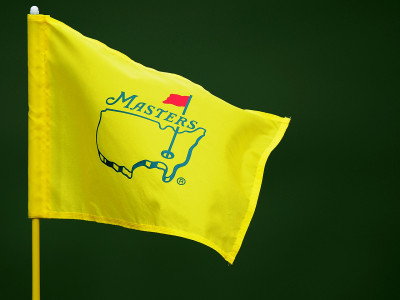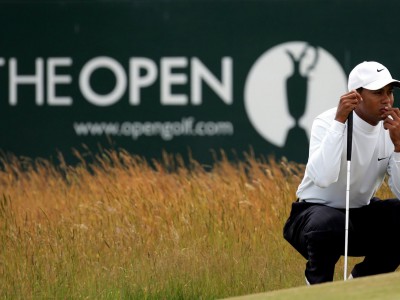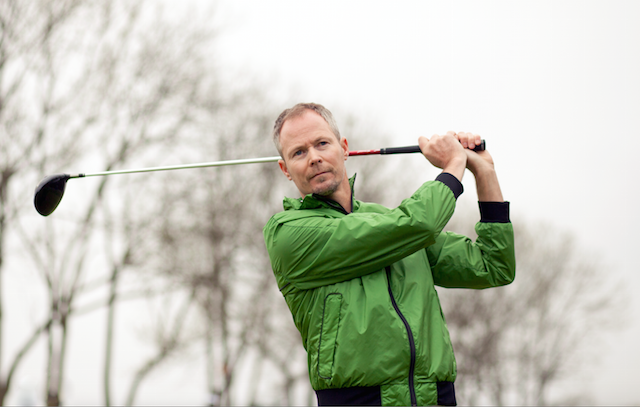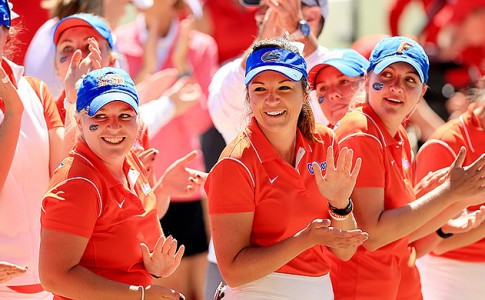He learned to play golf with a 7-iron golf club on the land around his parents’ house in South Africa. He dreamed about playing on the best courses with the best golfers. And he did it. As a self-taught person he reached the European Tour, where he played more than 370 tournaments over fifteen years and won the Irish Open. He was one of the Top 100 players in the official World Golf Rankings and with golf he experienced almost the whole world. Six years ago, he landed in the Czech Republic and as a coach he especially passes his experience on to young talents.
In an interview for GolfProfi Magazine he remembers playing with Tiger Woods, talks about the European Tour changes, as well as about the recipe for success and describes his plans for the future.
You played golf almost on every continent. Which places have made the biggest impression on you?
Every country is a little bit different and offers different golf courses, and that’s what I enjoy about golf. Even grass can be different. When I first played in Asia, I didn’t know how to play a chip around the greens, because the grass was totally different from that in South Africa. Back then I had to ask the locals how to do it (he’s laughing). From all the countries I visited, India and the Philippines are lodged in my mind. I was surprised by the extreme poverty I witnessed there. People lived in unbelievable conditions, which was a huge contrast to the golf courses, which, on the contrary, were perfectly maintained. They were completely different worlds.
Which tournaments did you like to return to?
I love tournaments with history and a great audience. In Europe, I looked forward to the BMW PGA Championship at Wentworth or the Irish Open, where I managed to win. Tournaments in America, such as the Phoenix Open in Arizona, were great too. Actually, the atmosphere there resembled a party, what a crazy place! It’s more of a golf show in America. I remember being in the flight with Davis Love III when I first played in America. We were announced, at our first tee, like boxers in the ring before their title match. What’s more, I was astonished by the number of people surrounding the area from the tee to the green. I hugely enjoyed it.
Speaking of crowds at the tee, a lot of us would be pretty stressed, maybe even close to a heart attack because of it, … so how hard is it to stand at the tee knowing that hundreds of eyes are watching you?
It’s like in showbiz; it must be inside you. If a singer isn’t capable of singing for a few people, how can he or she dare to appear in front of a packed music hall? You can be a great golfer, but if you can’t manage stress, there is no point playing golf. As for me, it’s difficult to perform in front of five people rather than five thousand. Playing in front of crowds is a part of the game and that’s what I also say to my trainees. They must be able to cope with it and know how to deal with nervousness so that they don’t end up paralysed; they should know how to keep nerves under control and how to use emotions in their favour. When I played a final round in a tournament and was in the lead, I couldn’t sleep. I was nervous, but at the same time I was looking forward to showing more to the audience.
You spent a long fifteen years as a European tour player. Was it a big adventure or rather a routine especially in the end?
Of course, it wasn’t the same over time. As a child, I dreamed about playing against great players on great courses. And I my dream came true. As I grew older I experienced more and what was once exciting for me, wasn’t anymore. It was much more difficult to look for motivation in the same things. However, I always managed to enjoy golf greatly.
How much has the European series changed since the days when you played it?
When I played, the season began in March and ended in October, meanwhile, we had five months off. We could relax, enjoy life, recharge batteries and regain strength. Now, golfers play virtually year-round and travel a lot since tournaments are held in Australia, South Africa or China. The game, and the swings, are a bit more aggressive. All these are factors, which lead to a greater number of injuries.
Should players have a more relaxed timetable?
Golf is not everything; it’s just a part of life. If you want to make it a living, you must enjoy it. A recipe for success is – feel the passion. But it’s necessary to rest, train, and do something else too. However, golfers play all the time nowadays, fighting for every cut and are often under great pressure when they fail.
You had a chance to play with lots of great players. How do you remember them?
I’m a sociable person; I’ve made friends with a lot of players from all over the world. But it’s a bit different with the top players. You don’t often have a chance to meet them since they have a lot of other duties. The only way to get in touch with them was during practice rounds. When we saw Seve Ballesteros go to the course we were soon on our feet in order to play with him. We ran to him and asked whether we could join, he nodded and we headed off. I also had the opportunity to play with Bernhard Langer, which was another amazing experience.
You also played with Tiger?
Yes, and it was a special round. At the beginning we shook hands, introduced ourselves, and then we didn’t utter a word. I’d never experienced anything like that. During a round I always talked with my partners about everything. With him, it was just “Hello” and “Thanks”. He was absolutely focused, didn’t look around. He was followed by photographers, crowds and security everywhere he went.
If players are more talkative than Tiger Woods, what do they talk about during rounds?
We crack jokes, talk about women, other sports, family, nice restaurants, houses, life, etc. It’s just a chit chat about anything. The chat helps feel relaxed and not think only about technique. This is a mistake a lot of golfers make.
The fact they focus on technique?
Yes. In golf there are plenty of other things you need to cope with. Like emotions, bad luck, bad sleep, bad swing, a messed up start of the round, 3-putts, etc. Technique is the last thing to have on your mind on the course. The key is to focus on the hole, and then switch off until the next stroke. When you throw a ball, you don’t think about technique either. You just grab and throw it. You can throw it over your head, below the knee, behind your back, not once will you think about how to do it – where to put your leg or how to turn. Golf must be played the same way. We aren’t machines; there is no perfect swing. Unfortunately, players are often taught only how to swing instead of really learning how to play golf. That’s crazy.
When I don’t want to learn how to swing, but play golf, what shall I do at the driving range?
People shouldn’t swing using the same style, club and still aim at the same targets. This isn’t what real golf looks like. Honestly, how many times have you hit a driver ten times in a row? You have to change your clubs, as well as the type of your swings. When I learned to play golf, I had one club – a 7-iron – and I played around the house. I had to play lobby, chips, long shots, everything with the 7-iron and I learned to play golf. It’s very important to know how to use a club to solve a particular situation, not just swing the same shots over and over again. A good swing won’t win a golf tournament.
I’m sure people ask you to look at their swings. How do you reply?
I tell them: Of course, but what am I looking at? What would you like to improve? It’s a dialogue. Eventually, they’ll have a good technique but will reach it via a “non-technical” way. They’ll enjoy it much more; they won’t feel humiliated and instructed.
You train a lot of young and talented players. According to you, what do they need to succeed?
Every successful player needs to have his or her own recipe. It isn’t money that makes you reach your goal; you need a recipe that works. Tiger Woods and Rory McIlroy are phenomenal players, yet neither of them came from affluent families. But they had a stable childhood and found their recipe. Tiger’s father was in the army; he instilled discipline, respect and willingness to work hard in his son. He was devoted to a lot of other sports too – and this is the recipe I’m talking about here.
What was your recipe?
The first step was when my dad introduced me to golf. He gave me the opportunity to play, work in the club and on the course, coach, set clubs. I didn’t go to golf camps in Spain or stay in five-star hotels. Dad didn’t use to spend a lot of money on me. And this was my own recipe. Of course, I’m neither Tiger nor Rory, but I think that there are plenty of children who would like to experience golf as much as I did.
Definitely. What advice would you give to their parents?
Children must stay children and enjoy their friends, family and various sports. They don’t need to be world champions at the age of twelve. It’s true that Tiger and Rory were successful when young, but Vijay Singh succeeded much later. Nick Price also played really well in his forties, as well as Jay Haas and Miguel Ángel Jiménez. Everyone is different and no shortcut will take you to the top. There are, after all, plenty of examples of players who were once successful in their teens but later no one heard about them anymore. The transition from the amateurs to the pros isn’t easy to handle. Well, to sum up – I’d advise parents to create a good environment in which children won’t be to afraid to make mistakes and play badly. It’s okay, and it belongs to the process of learning golf.
You’ve lived in the Czech Republic for six years. What are your ambitions?
I’d like to change the perception of golf so that people take it more as a sport, rather than a matter of status. In the Czech Republic there is still room for growth. Golf here is considered very expensive, too complicated, with a lot of barriers. It has a snobbish image. However, in Sweden and Scandinavia, golf is a sport for everyone. Sweden has a massive base of hundreds of thousands of players; in Finland, golf is played by bus drivers and cleaners. It’s not the same here. It’s high time that we changed the way golf is viewed by people and encouraged people to play.
How can that be achieved?
I’ve already started to realise my ideas. Because I missed the club feeling in the Czech Republic, I decided to embark on a new adventure and founded my own golf club. It’s for everyone with the same view of golf as me. I’d also like to introduce a golf membership system similar to the one in gyms. As part of such a membership, I want to offer lessons aimed at chipping, putting, game in sand, etc. The membership won’t be expensive, so that people can afford it. I believe that it’ll help draw more people to the game and that once they try it they’ll enjoy it.
Golf is a conservative sport. Does it need any changes?
Yes, but I don’t want it to change from the bases. We can still keep the traditions and, for instance, wear T-shirts with a collar, that’s fine. But it should be perceived as an entertainment – an easy and not very expensive sport. We need to tear down some of the barriers. It’s nonsense to have a handicap when you don’t want to play tournaments. Skiing is more dangerous than golf but you don’t need a green card to do it. In golf, it’s important to know how to behave on the course and what the rules are. That’s all you need to know and you can play. It requires a more relaxed approach, which can already be seen in America and England. There are driving ranges that resemble bowling. It looks like in an entertainment club where music is played and the young are having a great time. This is a good way to increase golf’s popularity.
Source: Interview with David Carter from GolfProfi Magazine










No comments